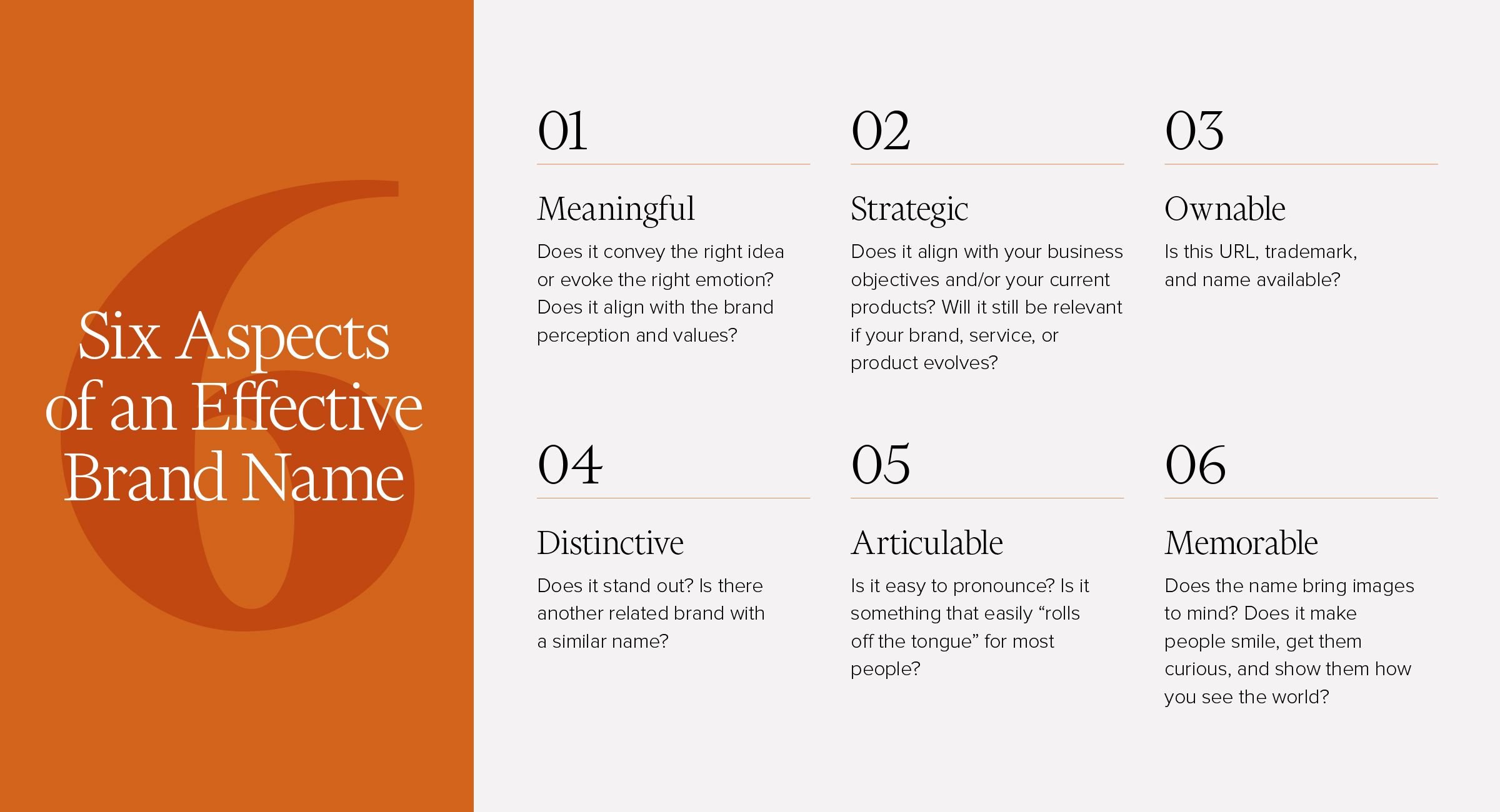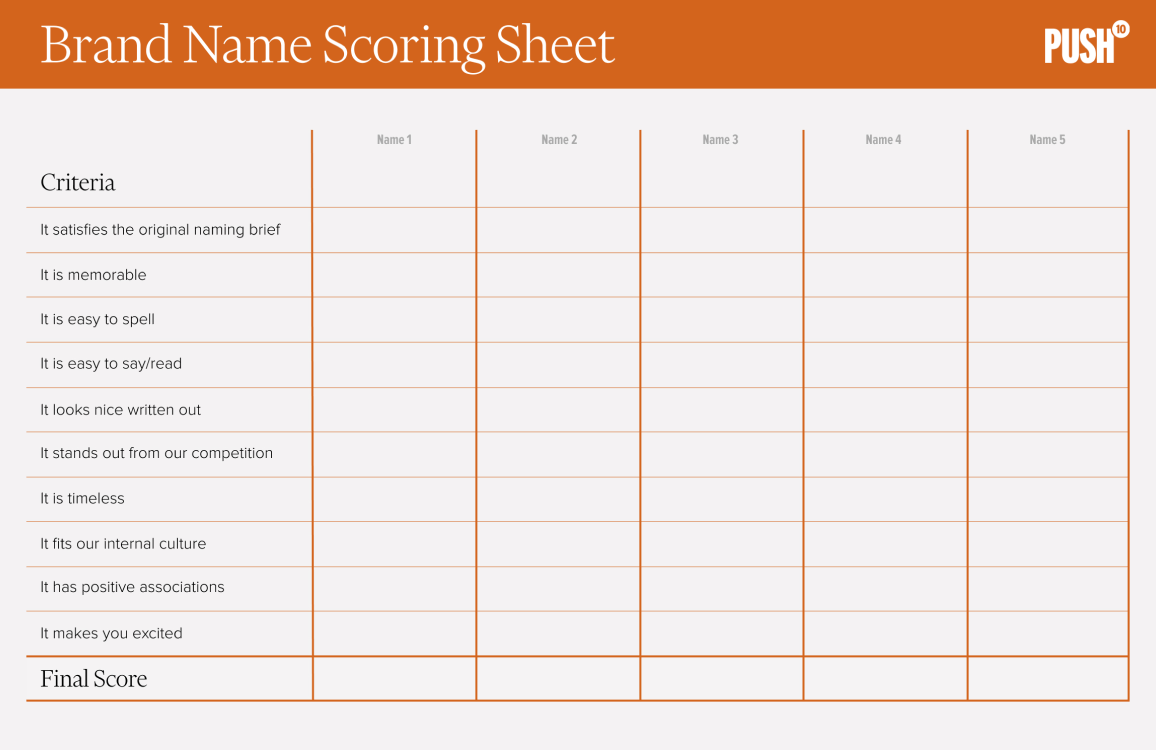We are first introduced to brand names when we are given our own. That moment decided what we’d come to write on our name tags, and how others might subconsciously evaluate us.
Brand names—like the ones our parents gave us—influence the perception of the products, companies, or services they represent. It’s an important consideration any business will face in the branding or rebranding process.
But how do you choose a good brand name? And once you’ve come up with one, how do you know if it’ll be successful?
These questions sound daunting until you fill in the context. So, to understand the nuances of naming a brand, let’s start from the top.
Why is a brand’s name important?
Your brand’s name contributes to and adopts your brand’s identity. It is often the first thing your audience learns about your business. And it is often what your audience will type into Google to learn more about you.
Also, and perhaps most importantly, it’s a clue for potential customers or clients as to who you are.
Pretend you’re on a date. Say the person sitting across from you at the dinner table had their heart broken by someone with your name. Fairly or unfairly, you’d have a hurdle to overcome to win their trust right from the start.
Or, for a more germane example, consider Apple’s name compared to Microsoft’s. Each builds comparable products, and each market to similar audiences. Yet, as their name reinforces, Apple positions themselves as the simpler, more accessible option, the opposite of Microsoft’s tech-heavy focus. It’s this positioning that many have attributed to Apple’s dominant performance among the average consumer.
Bottom line: a brand’s name doesn’t determine a business’s success, but it sure can influence it.
What makes a good brand name?
Branding as a discipline is half art and half science. Naming is no different. In order to judge whether or not a name is “good,” the units of measurement need to be as clear and as objective as possible.
When we consider what makes a brand name viable, we believe it should satisfy as many of the following six criteria as possible: It should be meaningful, strategic, ownable, distinctive, articulable, and memorable.
Ultimately, what makes a brand name effective is how it fits into our audience’s collective memory.
Much like a logo, a name will never—and I repeat, never—single-handedly cause someone to purchase a product or service. But it can influence that decision. That’s why it’s important to start from a solid foundation.

What does a successful brand naming process look like?
If there are a million ways to skin a cat, there are at least a million and one ways to name a brand. Much of this process will depend on how mature your business is, how many stakeholders will be involved, and whether you are naming a new brand or renaming an existing one.
Regardless, experience has taught us that defining a process from the outset and standing by that process is the best auger for a successful outcome.
Here’s the general process that we follow at Push10
Create a naming brief
This is a short, strategic statement that sets the direction for the upcoming process. It should be used throughout the subsequent exercises and brainstorms as a benchmark for whether a name idea is “on strategy.” Here’s a quick example for a modern, direct-to-consumer sofa company: The name for our company should be a bold yet friendly declaration of our brand’s innovative approach to selling furniture, while nodding to our roots as a family-owned business.
Large stakeholder brainstorm
Start the ideation portion of the brand naming process with a larger group of internal stakeholders. The goal is to generate as many options as possible that fit within the guardrails defined by the naming brief. Culling these options comes later. Ideas get better with time, so don’t expect to emerge with the perfect name after the first brainstorm.
Small stakeholder brainstorm
With a more focused group of stakeholders, work together to hone the list of name options to around 30-40. If any clear trends emerge, it is also a smart idea to start some preliminary trademarking/domain research now.
Final group brainstorm and research
After time has elapsed and the small stakeholder group has had the space to marinate on these ideas, it’s time to shorten the list down to four or five options. It is crucial at this time to do some more in-depth trademarking/domain research so you are not moving forward with a name that will be dead on arrival.
Larger group evaluation and scoring
With the heavy creative work done, we often find it beneficial to open up this process to a larger group of brand stakeholders. The scoring sheet below is an example of a rubric you can disseminate with the four-to-five name options selected. This helps control the feedback and more objectively choose a name that works for your brand.

Then, if all goes according to plan, a clear winner will begin to emerge. Establishing the perfect name provides a sign of hope, promise, and excitement for your new brand. Backed by concerted and deliberate branding and marketing strategies, your new name will soon resonate with your audience.
And what’s not to be excited about? You’re naming a brand—taking a step toward an important new beginning.
Ready to start the brand naming process?
Contact UsRecent Insights
How to Write a Great Brand Tagline
A tagline is important but when push comes to shove, it’s a bonus. If you can’t find a way to express your brand promise that will really make an impact, you might be better off without one.
11
Feb

11
Feb
How to Maximize the ROI of Your Branding Project
Setting your branding project up to maximize ROI can be daunting. Get the most out of your investment with these tips for branding and measurement.
16
Aug

16
Aug
The Benefits of Working with a Midsize Creative Agency
Discover the strategic advantages of partnering with a midsize agency like Push10, where personalized attention, agility, diverse talent, intentional size management, cost-effective solutions, and consistent quality converge to propel your branding and website design projects towards success.
15
Nov

15
Nov
